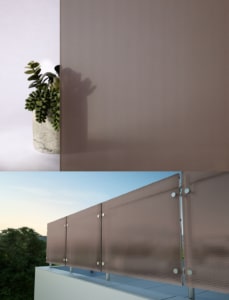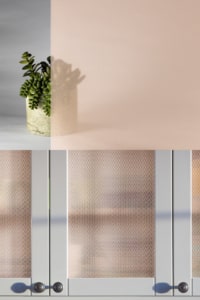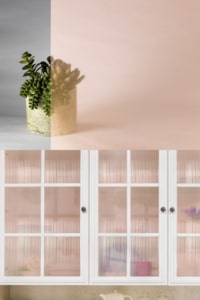





Colored glass has been around for centuries, beginning in ancient Roman times. Early examples of stained glass came from churches and monasteries. From the medieval era to the 1980s, stained glass and leaded glass were the main types of colored glass. The main applications of stained glass include windows, small panels, and light fixtures. Stained glass is no longer the standard for colored decorative glass. Limitations in size, cost, and the outdated aesthetic are all reasons for its decline.
The beginning of clear patterned (or textured) glass started in the mid-1800s and is a popular decorative glass today. Patterned glass is made using pattern rollers, heating, and cooling the glass after sending it through the rollers. Manufacturers can achieve vertical reeds, waves, geometric shapes, and other fun patterns. One way to make colored pattern glass is by laminating clear pattern glass to clear float glass and using a colored interlayer in the middle. This method can be costly and have limitations in color selection. Another way to get colored glass is by applying color to the back of the glass, or back painting. This type of glass will be opaque and have little to no light transmission. Back-painted glass works great for backsplash applications, elevator cladding, and wall panels.
Printing on glass is a new way to get custom colors onto glass, with fewer limitations. Some advantages of printing colors on glass are:
With digital printing, you can take original clear pattern glass, or clear float glass, to a new level. Colored pattern glass is in any application that uses regular clear pattern glass. Some ideal applications are cabinet inserts, shower doors, glass panels, and accent windows. After the colors print, the glass goes through the tempering process. This process ensures the ceramic ink fuses into the glass. Whether it’s a subtle hint of color or a bold splash, printed colors on glass can elevate interior spaces. Check out more about digital printing or connect with a sales rep.
Copyright © 2023 Architectural Glass, All rights reserved. This website and all materials continued herein are copyrighted and may not be distributed, modified, or reproduced in whole or in part without the prior written permission of Architectural Glass. The images from this site may not be reproduced in any form without the prior written consent of Architectural Glass. Architectural Glass actively and aggressively enforces its intellectual property rights to the fullest extent of the law.
